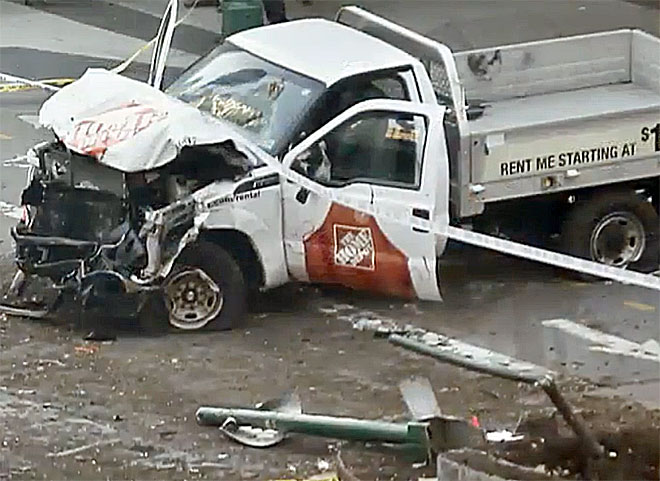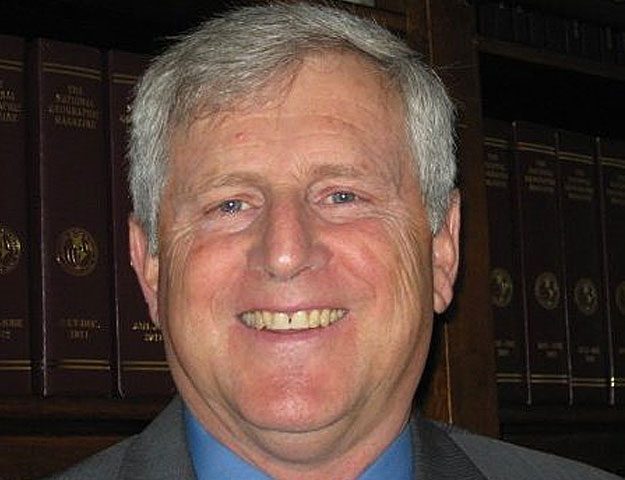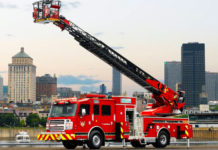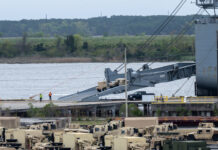
From the AST archives: This article was first published after the Barcelona ramming-vehicle attack during the summer and is reprinted here today due to it relevance to what happened in New York City yesterday.
By Doug Haines, MPSE, Haines Security Solutions
Just prior to boarding a plane I watched the news about the most recent terror attack in London.
My emotions were raging and I had to get it out of me. So I wrote about my first impression about the attack.
I sent it to American Security Today with the intent of writing a follow-up article a few months later, after my rage subsided and there was a chance to analyze what could have been done differently preceding the attack.
My original thought was to provide a more in-depth analysis on the use of a moving vehicle as a potential deadly weapon as has been the case increasingly across the world.
(2017 has been marked by deadly vehicle terror attacks across the globe. A look back at those attacks from Jerusalem, Paris, and London to New York City. Courtesy of Fox News and YouTube)
Due to events, in Nice, Stockholm London, and now again in New York City, where the perpetrators of those events used a similar threat tactic – ramming-vehicle, I think it would be unfair to security officials at those location to “arm-chair” quarterback what they “should have done”.
I believe it is much more prudent to look at these events in a broader context.
Identifying the Threat
First, and foremost, like every solution to a problem, the first step is to accurately identify the problem and its causes.
In today’s world there are actually two phenomena that run parallel when it comes to extremism.
First, the rhetoric that transforms someone into an extremist willing to carry out an attack on innocent men, women and children must be met with a counter-narrative that promotes inclusion and justice.
And, I’m not just talking Islamic jihadist here, all extremist follow the same path to radicalization.
Unless there is a counter-narrative to the one that is radicalizing these folks then our struggle will be prolonged and even harder.
(London Terror Attack: Watch a special report. Courtesy of Sky News and YouTube)
Secondly, the conditions that foster the rhetoric and make people susceptible must change; education, equality, inclusion and socialization, as well as other areas, so that these phenomena cannot get the oxygen it needs to breathe, survive and thrive.
Inclusion must also include the acceptance of a differ culture on both sides with all of its “western quirks” and conflicts.
I’m not saying that people should be allowed to do whatever they want in the name of their ethnic background but they should be able to practice their cultural norms within the legal context of the society they are part of.
(A hammer-wielding man was shot and wounded near the Notre-Dame Cathedral in Paris after targeting police officers outside the tourist and religious site. Courtesy of ABC News and YouTube. Posted on Jun 7, 2017)
Extremist’s will learn our tactics and counter them just as we will learned theirs and counter them, so the cycle continues until we change the playing field.
Developing an effective dialogue will take time, as will putting in place more institutions and societal programs that cause better integration and non-violent behaviors.
Unfortunately, it doesn’t take a very bright or sophisticated individual to wield a knife, or as happened in Paris on June 6th, a hammer.
The possibilities are endless.
So, let’s concentrate on what we can affect. The reduction of mass casualties through a variety of well thought out antiterrorism measures.
There are many and each threat has its own mitigation strategies.
Since, my first article was about someone using a vehicle to drive over people, I’ll concentrate on that one.

Separating Pedestrian and Vehicle Traffic
In so many cities, urban centers are a mixture of pedestrians and vehicle traffic.
City centers like, those in every major city worldwide have ample opportunities for actors with ill-intent to carry out attacks.
Places where large numbers of people congregate like; Times Square, Hollywood Boulevard, the Mall in Washington DC, are a combination of people moving in very close proximity to vehicles.
 This phenomenon is not limited to the States.
This phenomenon is not limited to the States.
City centers from Rome to Tokyo, Stockholm to Johannesburg, all have this mixture.
Usually it’s a pretty fluid mix and nothing “too bad” happens.
But sometimes, someone content on causing trouble can circumvent the “norm” and take advantage because, in reality we can’t protect against all threats all the time.
Many city centers have defined areas where people can walk freely without the influence of moving vehicles.
These pedestrian zones usually have a defined perimeter.
Sometimes the perimeter is hardened to some extent usually with bollards or flower pots.
Selected, authorized traffic is allowed inside of the established perimeter in some instances.
- As an example, a public bus system driver is given a clicker so that they can lower the bollard when they need access. After the bus enters the bollards are re-deployed.
- Delivery times for trucks have been established during non-peak pedestrian or low walking traffic times.
- Under normal circumstance this enough.

The basic concept of establishing a solid perimeter also works during short duration events, like activities that last a day or so and others that are longer in duration; such as, Christmas markets, a parade or other types of celebrations where the normal traffic flow is interrupted and the streets are used for other purposes.
If robust physical security devices are not in place, we use a policeman to monitor traffic and watch for the rogue vehicle.
Unfortunately, this idea is wrong. A metal stanchion with a guard near it is no match for a ramming vehicle.
Research shows us it takes time for a guard to notice a threat, usually 3-4 seconds and react to it 2-3 more seconds. So by the time a guard reacts the vehicle traveling at just 25 mph has traveled 133.5 ft.
If the normal speed of the roadway adjacent to a pedestrian zone is reduced further to 10 mph the vehicle will still travel 102.9 ft in the 5-7 seconds it takes the guard to react.
So any distance shorter than that provides the guard less reaction time.
Chances are by the time the guard reacts pedestrians will already have been hit or he/she will be under the vehicle while still trying to react.
What We Can Learn From Sporting Venues
We can learn something from the way sporting venues provide a layered approach to the moving vehicle threat.
A series on layers are established, usually starting some distance away from the venue.

They restrict vehicle traffic based on size, with each concentric circle around the host site, restricting access to decreasingly smaller vehicles.
We can and must do this everywhere that large crowds gather.
Not just in squares and parks but also along city streets, especially those that have high numbers of vehicle and pedestrian traffic using the same space.
We can’t do this just with signs. Bad actors won’t follow the rules of the road.
We will need to place physical barriers that limit movement and actually controlled it.
Something more substantial will be needed; specifically barriers that have been designed to mitigate the moving-vehicle threat.
What Can Be Done
We can start at the locations that have the highest volume and then on avenues of approach and at every additional layer reduce the size of the vehicle even further, so that any vehicle larger than a passenger vehicle doesn’t have access to the site.
I’ve been an advocate for keeping semi-trucks and large delivery vehicles out of city limits from some time now.
 They are just too dangerous to mix with passenger cars, bicycles and pedestrians in close proximity.
They are just too dangerous to mix with passenger cars, bicycles and pedestrians in close proximity.
This will take some getting used to. After all, a lot of our society is based on convenience.
I don’t think we need to sacrifice convenience for safety and security.
We can have both, we just have to plan and design for it.
I don’t think we need to sacrifice convenience for safety and security. We can have both, we just have to plan and design for it.
But what happens, if a vehicle larger than the one we’re allowing access or someone who is already inside of the restricted zone goes “rogue”?
In both scenarios people will get hurt and perhaps die unless we change the way we design high-occupancy spaces, especially those outdoors.
Within pedestrian zones we can keep the injuries and death toll down by creating areas of refuge to afford a person the opportunity to jump out of the way and hide behind in order not to be hit at the first sign of trouble.

Fortunately, specifically designed shallow-mount stationary benches, flower planters, trash cans, light poles, way signs, etc. are already on the market.
Immediately after the Westminster bridge incident, the London security forces started placing concrete barriers along highly trafficked routes to prevent the unintentional mixture of vehicle and pedestrian.
This is also occurring in Milan and New York and other cities across the globe.
Unfortunately, this is a temporary fix and is extremely unsightly.
I imagine plans are in place to replace the concrete barriers with more aesthetically pleasing barriers.
At least, I hope so. I don’t know anyone who wants to live in what looks like a war zone.

Additionally, if set up in a serpentine fashion the clusters of “barriers” could actually slow the vehicle to a speed that will allow people to get out of the way.
There should be no “clear shot – straight aways” within a pedestrian zone, period.
A longer term fix would be to raise the height of the curb by a few inches, from the standard six inches to say 8-12 inches.
We already do this for streets that are on hills, especially in residential areas.
Why not on all high volume streets, too?

The added height would cause a concerted effort by the driver to breach it and may therefore give pedestrian just an extra few moments to seek cover, which may be just enough to save lives.
To implement any type of permanent solution to the ramming-vehicle threat will take time and, maybe even more importantly money.
First, we have to be patience and understand that permanent solutions won’t happen overnight.
Secondly we need to impress of our leaders to do whatever they can now, with the limited resources they already have available and to develop a long-term strategy that will offer the most protection to the greatest number of people first.
The goal is to prevent mass casualties wherever and whenever we can.
About the Author:

Doug Haines is the owner and CEO of Haines Security Solutions (HSS) in Ventura, California.
He’s widely respected and sought after for his subject matter expertise in developing building design strategies.
Whether lecturing in academia or at a security industry forum, he’s an impassioned speaker and likes sharing.
Doug routinely contributes to security publications world-wide, and was named the 2016 Sandy Jones Volunteer of the Year, by the Security Industry Association (SIA), for his significant contributions to the security industry.
Haines Security Solutions is a Finalist in 2017 ‘ASTORS’ Homeland Security Awards Program

The 2017 ‘ASTORS’ Homeland Security Awards Program, organized to recognize the most distinguished vendors of Physical, IT, Port Security, Law Enforcement, First Responders, (Fire, EMT, Military, Support Services Vets, SBA, Medical Tech) as well as the Federal, State, County and Municipal Government Agencies – to acknowledge their outstanding efforts to ‘Keep our Nation Secure, One City at a Time.’
As an ‘ASTORS’ competitor, the Haines Security Solutions is competing against the industries leading providers of Homeland Security Education Programs.
 American Security Today will be holding the 2017 ‘ASTORS’ Awards Presentation Luncheon at 12:00 p.m. to 2:00 p.m, Wednesday, November 15th at ISC East, the Northeast’s largest security industry event, in the Jacob Javits Exhibition Center in New York City.
American Security Today will be holding the 2017 ‘ASTORS’ Awards Presentation Luncheon at 12:00 p.m. to 2:00 p.m, Wednesday, November 15th at ISC East, the Northeast’s largest security industry event, in the Jacob Javits Exhibition Center in New York City.
At ISC East you will have the chance to meet with technical reps from over 225 leading brands in the security industry, allowing you to find out about new products and stay ahead of the competition.
Encompassing everything from Video Surveillance and Access Control to Smart Home Technologies and Unmanned Security, you’re sure to find products and services that will benefit your company and clients.
To register for the ‘ASTORS’ Awards Presentation Luncheon at ISC East, in the Jacob Javits Exhibition Center from 12:00pm – 2:00pm, click on the banner below, or go to https://americansecuritytoday.com/product/awards-luncheon/
Good luck to Haines Security on becoming a Winner of the 2017 American Security Today’s Homeland Security Awards Program!
For more information, contact Doug Haines, or visit the company website at Haines Security Solutions.

















